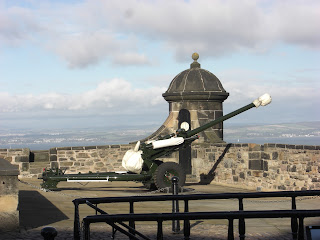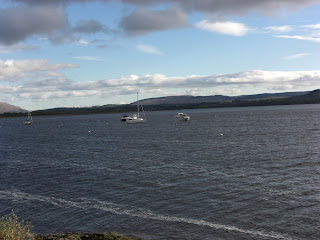We had an early morning on our last day in Glasgow. We decided to spend the day out in the country touring. We were able to book a day tour that included visits to Stirling Castle, The Trossachs, Loch Lomond, and the Glengoyne Scotch Distillery.
We made our way out of Glasgow in the middle of rush our on our little mini bus. There were about a dozen of us on the tour, with folks from Canada, the US, England, and Germany. Bruce and I had checked out of the hotel that morning and our driver was kind enough to let us keep our luggage in the back of the bus since the tour would drop us off right near the train station where we could catch our train to Edinburgh.
Our first stop was Stirling Castle, one of the most important castles in Scotland. The structures sit atop a steep rock formation surrounded by large drop offs on three of it's four sides. The castle was the site of many of the Scottish King and Queen Coronations, including the most famous, Mary, Queen of Scots in 1543. The site is now treated as an ancient monument and is run by Historic Scotland, a branch of the government that manages and oversees all the historic and tourist sites in the country.

The hill upon which the castle sits goes back at least 350 million years, and was formed out of glacier movement during numerous Ice Ages. The area may have served as a fortification as far back at the 7th century, but the first record is in 1110 when King Alexander I dedicated a small chapel that was built there. The site was a key battle ground in the numerous wars for Scottish independence and passed back and forth between the English and Scottish on several occasions. The entrance to the castle has a monument to Robert the Bruce, the famous Scottish King who reclaimed the land for Scotland during the Wars for Independence.


The present buildings that make up the castle were built between 1400-1600 during the Stewart Dynasty of rulers. The architecture of the buildings reflect English, German, and French styles, showing the dynasty's desire to be to seen as cosmopolitan by neighboring countries. The site served primarily as a residence for the Royals, including the famous Mary, Queen of Scots. She would meet an untimely end when her cousin Queen Elizabeth had her beheaded (a whole Catholic-Protestant thing). Mary's son James would eventually rise to be crowned King of England after Elizabeth's death, uniting the two kingdoms.
 |
| The Great Hall, which at the time was the greatest example of Renaissance influence in Scotland, built in 1497 |
The Castle then reverted back to a military installation. It was actually inhabited by the military until 1964 when the War Office turned it over as a historic site.
As we left the Castle, we got a distant view of the William Wallace Monument (think of Mel Gibson's Braveheart). Unfortunately, we did not get a chance to visit the site.
While it was bright and sunny outside, a cold front had moved in and it was painfully cold. We could not layer enough and had to resign ourselves to just being cold. Snow had actually started to fall north of us, but at least we managed to avoid that.
From Stirling, we made our way to the Trossachs National Forrest while Bruce managed to grab a nap.
The Trossachs is a vast piece of land comprised of lochs (lakes), bens (mountains), and glens (valleys). It's the fourth largest park in the British Aisles, with designated conservation areas and a forest named in honor of Queen Elizabeth II. I had actually visited the Trossachs back in 2005 on a visit to see my friends Carla and Steven. I spent a day here with Steven and we visited Loch Katrine. But this would be my first time to Loch Lomond.
Before heading to Loch Lomond, we stopped in Aberfoyle for lunch. The town is now a hot spot for tourists, but long ago was the home of cattle robber Rob Roy and in 1547 Mary, Queen of Scots sought refuge here to avoid the English Army. We had a traditional English lunch of steak and ale pie, mashed potatoes and peas. Bruce also got to try his first sticky toffee pudding which was "outstanding".
The most physically challenging part of the day would be our visit to Loch Lomond. The loch is the largest fresh water lake in Great Britain. It is 24 miles long and up to 5 miles long in some parts. Only Loch Ness (home of the monster) has more water by volume (it's a much deeper lake). It's popular for it's scenic views and during the summer is a favorite place for boating enthusiasts. It even inspired a song.
Oh, ye'll tak' the high road, and I'll tak' the low road,
And I'll be in Scotland afore ye';
But me and my true love will never meet again
On the bonnie, bonnie banks o' Loch Lomond.
The song was first publish in the 1800's but legend has it that it was penned by a Scottish soldier awaiting enemy execution. In a letter home, he wrote those words, lamenting that he would never see his beautiful homeland again. Talk about a downer.
We arrived at the Loch with the goal of climbing a steep hill that would give us a better view of the lake. I was a little worried about Bruce and his leg, but he managed it like a trooper. He would later confess just how painful it was, the poor guy.
We enjoyed some impressive views both at the peak as well as along the lake. I ventured to touch the water and it was COLD. Not really swimming weather this time of year I guess.
Our last stop would be the Glengoyne Distillery. Remember that Bruce and I share a love of Scotch, so we were very excited about getting to tour a Single Malt Distillery.
The Glengoyne Distillery (Glengoyne means Glen of the Wild Geese) has been in continuous operation since 1833. Prior to that time, the production of scotch was illegal, but the area surrounding the distillery was known to be full of secret stills, so it is assumed that production only "officially" began in 1833 after whisky production was made legal. Glengoyne was also the official supplier of single malt scotch to the Queen Mum until her death.
It is unique in that it is a Highland Malt, but is matured in the Lowlands. Unlike many other Distilleries, which use peat rock to dry their barley, Glengoyne uses warm air. Therefore the peaty aftertaste found is many single malts is not present in Glengoyne scotch. The Distillery produces close to 1 million liters of alcohol per year.
We also learned from our guide that the blended whiskies that are so popular (Dewars, Johnny Walker) are made from fermented barley from numerous different batches so there is no consistent flavor. We also learned that Dewars adds caramel coloring to give it's brand that amber color. In Single Malts, the color comes naturally from aging in casks. Bruce has always been a big blended fan, but I think this experience might have helped his tastes evolve a bit.
We got to visit the mashing and fermentation rooms (cameras were not allowed to protect the integrity of the product). The storage rooms where it matures are strictly off limits, but we got to see some examples. We paid for the double tasting, so we got to try some 10 year upon our arrival and some 12 year at the end of the tour.
I walked away from the experience with a new appreciation and understanding for scotch and also learned not to be so snobby about people who add a wee bit of water to it. It actually takes away the burn from the alcohol and allows you to enjoy the flavor.
Our drive back to Glasgow started just as the rains came. We were lucky that we did not have any during the day, but by the time we go to Glasgow, it was a full down pour and it was cold. Luckily we had a short walk over to the train station. We accidentally bought the off peak tickets, so we had to wait an extra 15 minutes until it was 6:30 so we could take the designated train. It's kind of a crazy mad dash to get to the train and with more people than seats, everyone scrambles. I think we unintentionally stowed away in first class, but Bruce got a seat and I got one after we reached the first stop. The train ride took about an hour and from the train station in Edinburgh it was a quick cab ride to our illustrious digs at the Caledonian Hilton. Of course we were upgraded, as Bruce is Diamond. It was one of the times I was grateful for class differences. I've never seen two guys so happy to have wi-fi.

It was bitterly cold, but we walked a few blocks over to an Italian Restaurant for a hearty dinner and the maitre'd and Bruce talked about the Tampa Bay Buccaneers. We were fading fast though, as it had been a long day, so we hobbled back to our suite and called it a night.




























































